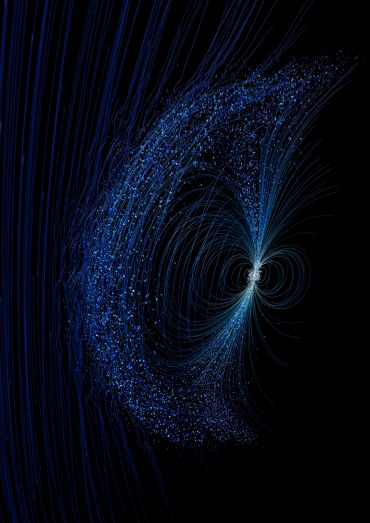
Scientists solve mystery of why comets emit X-rays
The mystery of how comets are able to emit X-rays has been solved by a team led by the University of Oxford.
The research published in Nature Physics considers the longstanding scientific question of how comets are able to radiate X-rays. A conundrum that is particularly puzzling, given that such emission is normally associated with very hot objects like the Sun, and comets are among the coldest objects in the Solar System.
When comets travel through the Solar System they interact with Solar radiation, the Solar wind and the Solar magnetic field. This produces a visible atmosphere or ‘coma’ as well as the observed cometary tail, and in some cases, X-rays. These are generated on the Sun-ward side of the comet where the Solar wind impacts the cometary atmosphere, forming a bow shock.
To investigate how the X-rays are generated, a team of scientists from 15 institutes, including the Universities of Arizona, Belfast, Copenhagen, Chicago, Lisbon, London, Osaka, Oxford, Paris, Strathclyde, Taiwan, as well as AWE Aldermaston, ETH Zurich, RAL Chilton, , performed experiments at the LULI laser facility in Paris, where they replicated the interaction of the Solar wind with a comet.
The Oxford team was led by Professor Gianluca Gregori, Professor Subir Sarkar and Professor Tony Bell, all at the Department of Physics.
Alexandra Rigby, an Oxford University student who is doing her doctoral work on the project and led the experiment said: “The laser beams are fired onto a plastic foil which explodes, causing a stream of electrons and ions to be expelled forming a high speed flow of ionised gas (plasma) like the Solar wind”.
The research revealed that when this plasma flow impacts onto a solid sphere, the laboratory ‘comet’ (placed about a centimetre away from the plastic foil), it resembles what happens when a real comet passes through the Solar system. It was found that electrons are heated to about a million degrees in the up-stream region by plasma turbulence.
These hot electrons are responsible for emitting X-rays in the presence of a magnetic field.
‘These experimental results provide direct laboratory evidence that objects moving through magnetized plasmas can be sites of electron heating,” said Professor Gregori. “This process is common in astrophysics and can take place not only in comets, but also in planetary magnetospheres (as of our own Earth), or even in supernova remnants where the ejected material sends a shock wave into the interstellar gas’.
This work also sheds light on another cosmic mystery, how high energy particles are generated in Nature. This latest experiment clearly demonstrates that plasma turbulence can provide the initial source of fast particles in, supernova shock waves, for example.
Professor Sarkar said: ‘As a theorist I find it amazing that it is possible to sensibly replicate astrophysical phenomena in the laboratory, to test our physical understanding of how cosmic particle accelerators may work’.
This project was carried out under the auspices of the European Research Council (ERC) and the UK Engineering and Physical Sciences Research Council (EPSRC). The numerical simulations were done on the MareNostrum supercomputer at the Barcelona Supercomputing Center, the IST cluster at Lisbon, and the Asterix cluster of the Flash Center for Computational Science at the University of Chicago.

 New analysis of archaeological data reveals how agriculture and governance have shaped wealth inequality
New analysis of archaeological data reveals how agriculture and governance have shaped wealth inequality
 Cambridge victorious in Women's and Men's Boat Races 2025
Cambridge victorious in Women's and Men's Boat Races 2025
 Expert Comment: Ethical and legal challenges of uterus transplants in Mexico
Expert Comment: Ethical and legal challenges of uterus transplants in Mexico